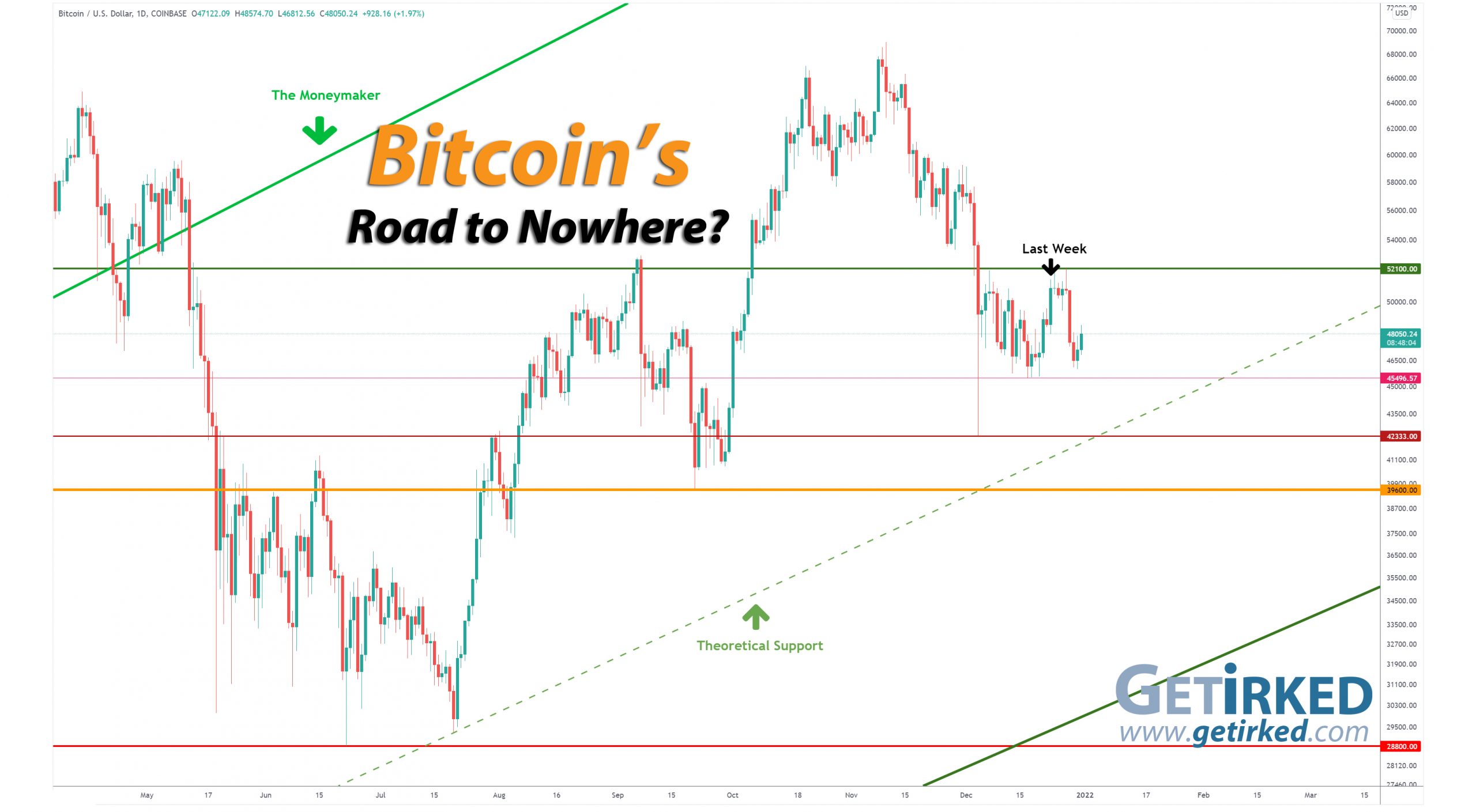Summing Up The Week
The last week of the trading year is usually quiet with many professionals taking a much-needed vacation, and this week was no different. The market continued to melt-up into year-end, representing the continuing Santa Claus Rally many analysts had been touting since much earlier in December.
Let’s take a look at the news that moved the markets (or didn’t) this week…
Market News
Holiday sales rise 8.5% despite Covid
Over the holiday weekend on Sunday, Mastercard SpendingPulse reported holiday sales rose 8.5% year-over-year, reported CNBC. While many analysts demonstrated surprise over this figure seeing the omicron variant of Covid-19 as a potential dissuader to those who would like to gout shopping, I am not remotely surprised since we’re talking about year-over-year figures and, in 2020, everyone was more-or-less still in lockdown.
Purchases in clothing and jewelry provided the majority of the boost to spending with increases of 47% and 32%, respectively. The real surprise came in the form of online sales, which increased 11% from 2020 and a pretty impressive 61% from 2019, an indication of potentially permanent habit-changing in American consumers.
Airlines cancel more than 1,500 flights due to omicron
The omicron variant of Covid-19 wreaked havoc on the airlines over the vital holiday weekend travel, with more than 1,500 flights canceled over the course of the weekend throughout of all the major air carriers, reported CNBC on Sunday.
Delta Air Lines (DAL) appeared to suffer the largest amount of cancelations with data from the tracking site FlightAware showing DAL as canceling 5% of its schedule – 139 flights – on Sunday following a cancellation of 310 flights on Saturday.
“Like many businesses and organizations, we have seen an increasing number of sick calls from Omicron,” said a JetBlue spokesman in a statement. “Despite our best efforts, we’ve had to cancel a number of flights, and additional flight cancellations and other delays remain a possibility as we see more Omicron community spread.
Weekly jobless claims hit 52-year low
Previously, I said I wouldn’t report the weekly jobless claims figure since it’s often irrelevant to the market movements, however, this week was significant on Thursday when the Labor Department reported new weekly jobless claims of 198,000, less than expected and a 52-year low, reported CNBC.
After adjusting for weekly volatility, the four-week moving average for claims came in at 199,250, the lowest level since October 25, 1969. The improvement in the jobs market will likely motivate the Federal Reserve to stay the course on their current plan of a faster tapering of bond purchases as well as a “lift-off” start date to increase the interest rate somewhere near the end of Q1-2022.
Next Week’s Gameplan
With the Santa Claus Rally in effect, historical trends dictate that the rally will take us through a few of the first trading days in the new year. However, following a year with such dramatic upside (the S&P 500 increased more than 25%!!!), I am expecting a pullback sometime in the first few months of 2022.
While I can’t predict the extent of the pullback, I am readying my portfolios by eyeing buying price targets for each of my positions so I can start adding at lower levels.
In the meantime, let me take this chance to wish you and yours a very Happy New Year! I’ll see you back here in 2022!
This Week in Play
Stay tuned for this week’s episodes of my two portfolios Investments in Play and Speculation in Play coming online later this weekend!
Crytpo Corner
Important Disclaimer
Get Irked contributors are not professional advisers. Discussions of positions should not be taken as recommendations to buy or sell. All investments carry risk and all readers must accept their own risks. Get Irked recommends anyone interested in investing or trading any asset class consult with a professional investment adviser to determine if an investment idea is suitable to them and their investment goals.
Click chart for enlarged version
Bitcoin Price (in USD)
%
Weekly Change
Bitcoin Price Action
Crypto Consolidation Continues…
Bitcoin continued to bounce between levels this week, even after having a pretty significant selloff Tuesday through Wednesday. Still, the crypto has held its $45,496.57 weekly low and did actually make a new weekly high at $52,100.00 on Tuesday right before the dump started.
From here, the determining factors rest on the direction Bitcoin moves next and whether previous lows hold. We’re looking at $42,333.00 followed by $39,600.00, and, then, $37,300.00. If $37K fails, we’ll likely be checking out the $28,800-$31,000 range.
The Bullish Case
Bulls continue to believe institutional buying will be the catalyst to push Bitcoin higher. Bullish analysts still believe prices deep into the 6-figure territory are in the crypto’s very near future.
The Bearish Case
Bears point to Bitcoin’s inability to recover from the ongoing macro routs as the indicator that the crypto will head for lower-lows. The theory that Bitcoin will hit $20,000 before it makes any new all-time highs continues to stay at the forefront of any bearish analysis.
Bitcoin Trade Update
Current Allocation: 2.603% (+0.327% from last update)
Current Per-Coin Price: $50,615.32 (-0.199% from last update)
Current Profit/Loss Status: -5.068% (-1.182% from last update)
When Bitcoin popped over my per-coin cost early in the trading week, I decided it was time to trim a little allocation with a sale on Monday that filled at $51,885.74. The sale only lowered my per-coin cost -0.098% from $50,716.42 to $50,666.67, but, more importantly, reduced my allocation a bit, dropping it -0.135% from 2.276% to 2.141%.
On Tuesday, the bottom in the crypto market once again fell out and Bitcoin dropped through my next buy target at $47,368.50. The buy lowered my per-coin cost -0.088% from $50,666.67 to $50,621.90 and raised the allocation +0.195% from 2.141% to 2.336%.
On Thursday, I made another fat-finger error, mis-entering a buy order that filled immediately instead of my intended price target which was much, much lower. As always, discipline dictates that while mistakes happen, they must be fixed immediately. Rather than trying to re-evaluate the trade with the accidental purchase, the first thing to do is sell the mistake, even at a loss (as it was in this case).
Due to trading fees and the size of the accidental buy (which was unfortunately substantial), the error increased my per-coin cost +1.049% from $50,621.90 to $51,152.74; a big bummer to be sure, but it happens.
On mid-day Friday, Bitcoin gave me a bit of a chance to redeem myself when it started pulling back, filling a buy order at $46,229.44 which lowered my per-coin cost -1.051% from $51,152.74 back down to $50,615.32 and increased my allocation +0.267% from 2.336% to 2.603%.
Bitcoin Buying Targets
Using Moving Averages and supporting trend-lines as guides, here is my plan for my next ten (10) buying quantities and prices:
0.053% @ $44,132
0.156% @ $42,332
0.525% @ $40,103
0.551% @ $38,806
2.098% @ $34,707
4.224% @ $29,912
6.556% @ $26,151
6.032% @ $24,309
16.03% @ $20,962
1.783% @ $18,809
No price target is unrealistic in the cryptocurrency space – Bullish or Bearish.
While traditional stock market investors and traders may think the price targets in the cryptocurrency space are outlandish due to the incredible spread (sometimes a drop of near -90% or a gain of up to +1000% or more), Bitcoin has demonstrated that, more than any speculative asset, its price is capable of doing anything.
Here are some of Bitcoin’s price movements over the past couple of years:
- In 2017, Bitcoin rose +2,707% from its January low of $734.64 to make an all-time high of $19,891.99 in December.
- Then, Bitcoin crashed nearly -85% from its high to a December 2018 low of $3128.89.
In the first half of 2019, Bitcoin rallied +343% to $13,868.44. - From June 2019, Bitcoin crashed -54% to a low of $6430.00 in December 2019.
- From December 2019’s low, Bitcoin rallied +64% to $10,522.51 in February 2020.
- In March 2020, Bitcoin crashed nearly -63% to a low of $3858.00, mostly in 24 hours.
- Then, Bitcoin rallied +988% to a new all-time high of $41,986.37 in January 2021.
- Later in January, Bitcoin dropped -32% to a low of $28,732.00.
- In February 2021, Bitcoin rallied +103% to a new all-time high of $58,367.00.
- Later in February, Bitcoin dropped -26% to a low of $43,016.00.
- In March 2021, Bitcoin rallied +44% to a new all-time high of $61,788.45.
- Later in March, Bitcoin dropped -19% to a low of $50,305.00.
- In April 2021, Bitcoin rallied +29% to a new all-time high of $64,896.75.
- In June 2021, Bitcoin crashed -56% to a low of $28,800.00.
- In November 2021, Bitcoin rallied +140% to a new all-time high of $69,000.00.
- In December 2021, Bitcoin dropped -39% to a low of $42,333.00.
Where will Bitcoin go from here? Truly, anything is possible…
What if Bitcoin’s headed to zero?
The only reason I speculate in the cryptocurrency space is I truly believe Bitcoin isn’t headed to zero.
I am prepared for that possibility, however, by knowing I could potentially lose all of the capital I’ve allocated to this speculative investment. Professional advisers recommend speculating with no more than 5% of an investor’s overall assets. Personally, I’ve allocated less than that to speculating in crypto.
I feel that anyone who doesn’t fully believe in the long-term viability of cryptocurrency would be better served not speculating in the space.
On a good day, this asset class isn’t suitable for those with weak stomachs. On volatile days, the sector can induce nausea in the most iron-willed speculator. If a speculator isn’t confident in the space, the moves will cause mistakes to be made.
DISCLAIMER: Anyone considering speculating in the crypto sector should only do so with funds they are prepared to lose completely. All interested individuals should consult a professional financial adviser to see if speculation is right for them. No Get Irked contributor is a financial professional of any kind.
Ways to give back to GetIrked:
Send me a tip via Stripe! Thank you!
Get free money by signing up for an account with my referral link for Schwab
Sign up for Gemini and we each get $10
Click this referral link to get the Brave Browser
If you use Brave, you can also use the Tip function to tip me in Basic Attention Token (BAT).
Suicide Hotline – You Are Not Alone
Studies show that economic recessions cause an increase in suicide, especially when combined with thoughts of loneliness and anxiety.
If you or someone you know are having thoughts of suicide or self-harm, please contact the National Suicide Prevention Lifeline by visiting www.suicidepreventionlifeline.org or calling 1-800-273-TALK.
The hotline is open 24 hours a day, 7 days a week.


